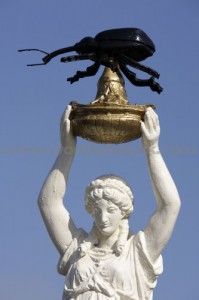People build monuments to great leaders, war heroes, saints, and other admired figures, but why would anyone honor a pest in this way? In my new book, Nothing is Wasted, I explore the idea that in the midst of all the calamity, pain, and difficulty of life, God has planted hints of redemption throughout the universe in unexpected places.
One example I refer to in the first chapter is the Boll Weevil Monument in Enterprise,  Alabama. Why did the people build it? The following excerpt from the book suggests the answer:
Alabama. Why did the people build it? The following excerpt from the book suggests the answer:
When a Destructive Insect Embodies Redemption
The boll weevil is an ugly little insect that loves cotton. Over the past hundred years, it has caused billions of dollars in damage to cotton crops in the United States and elsewhere. Numerous farmers across the decades have gone bankrupt because of this one pest. Scientists have used every means they can think of to try to eradicate it—pesticides, wasps, fungi, specially engineered anti-weevil cotton plants, and other methods. The fight against it continues to this day, and the eradication programs have been largely successful.
No one sheds a tear for the boll weevil. Just about everybody wants to kill it. So I was surprised when my friend Jim Davis, who lives in Alabama, a state that historically has been plagued with weevils, told me that a town named Enterprise, Alabama, has a boll weevil monument prominently displayed in the center of its downtown.
A monument to a destructive insect would be surprising in any town, but for Enterprise, Alabama, to honor such a creature seems especially strange, considering the destruction the boll weevil has wreaked on that town and the surrounding county. As the town’s historians report, in the early twentieth century, the boll weevil destroyed almost 60 percent of the county’s main crop of cotton, and farmers were at risk of utter ruin.1 Their failure would have meant devastation for the entire economy of that region.
The monument the town built to this pest in 1919 features a statue of a woman standing in Statue-of-Liberty-like robes, her arms held high above her head. In her hands, on top of a kind of pedestal, stands a large and ugly boll weevil. A flowing fountain surrounds this statue.
The farmers in Coffee County, Alabama, where Enterprise is located, were determined not to let the boll weevil defeat them. Instead, they turned its destructive behavior into an opportunity to diversify their crops and be more successful in the long run. If the crisis of the boll weevil had not forced the issue, they might never have made changes and would have missed out on the prosperity the shift brought them. Peanuts in particular became an especially profitable crop for the region.
As the Enterprise history relates, “By 1917, Coffee County produced and harvested more peanuts than any other county in the nation. (In 1993, Coffee County ranked 4th in the state of Alabama with 128,000 acres planted in peanuts.)” The plaque that accompanies the monument states, “In profound appreciation of the Boll Weevil and what it has done as the herald of Prosperity this monument was erected by the citizens of Enterprise, Coffee County, Alabama.” The work of a pest was redeemed.
Read more in Nothing is Wasted: How God Redeems What is Broken (Beacon Hill Press, 2016).